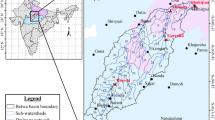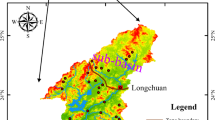Abstract
Climate change leads to increasing intensity and frequency of extreme rainfalls, especially in Taiwan with steep slopes and rapid currents. Heavy rainfalls trigger serious erosion and landslides on hillslopes, which increase sand concentration in rivers, and thus affect the water quality of reservoirs and the ecohydrological functions of rivers. We take the Zhuoshui River basin as an example and applied the modified Soil Water Assessment Tool (SWAT) model, SWAT-Twn, to simulate sediment in the basin. In SWAT-Twn, estimation of sediment yield is carried out by integrating the Taiwan Universal Soil Loss Equation (TUSLE) and the landslide simulation. Results of daily streamflow simulation showed that the model performances were above the satisfactory level, while simulations of daily sediment loads showed that the SWAT-Twn model performed better than the official SWAT (SWAT664), in terms of PBIAS of − 46.6 to 16.0% (SWAT-Twn) and − 1.2 to − 107.0% (SWAT664). Two scenarios of land use/cover, scenario 1 with fixed land use/cover and scenario 2 with updated land use/cover in each year, were applied to simulate annual sediment in the river basin for investigating the effects of landslide area variation on sediments. Results of sediment simulation under the two scenarios showed that although updating landslide area may facilitate sediment yield simulation at the subbasin level, the sediment transport equation, Bagnold equation, does not reflect the variation in sediment loads in the watershed. With further modifications, SWAT-Twn is expected to be an effective tool for simulating the impacts of landslide on sediment loads in the watersheds with rainfall-induced landslide.








Similar content being viewed by others
Availability of data and material
The data that support the findings of this study are available from Central Weather Bureau and National Land Surveying and Mapping Center, Taiwan, but restrictions apply to the availability of these data, which were used under license for the current study, and so are not publicly available.
References
Abbaspour, K. C. (2015). SWAT-CUP: SWAT calibration and uncertainty programs-a user manual. EAWAG.
Abbaspour, K. C., Rouholahnejad, E., Vaghefi, S., Srinivasan, R., Yang, H., & Klove, B. (2015). A continental-scale hydrology and water quality model for Europe: Calibration and uncertainty of a high-resolution large-scale SWAT model. Journal of Hydrology, 524, 733–752.
Arnold, J. G., Bieger, K., White, M. J., Srinivasan, R., Dunbar, J. A., & Allen, P. M. (2018). Use of decision tables to simulate management in SWAT+. Water, 10(6), 713. https://doi.org/10.3390/w10060713
Arnold, J. G., Moriasi, D. N., Gassman, P. W., Abbaspour, K. C., White, M. J., Srinivasan, R., Santhi, C., Harmel, R. D., van Griensven, A., Van Liew, M. W., Kannan, N., & Jha, M. K. (2012). SWAT: Model use, calibration, and validation. American Society of Agricultural and Biological Engineers, 55(4), 1491–1508.
Bieger, K., Hörmann, G., & Fohrer, N. (2014). Detail spatial analysis of SWAT-simulated surface runoff and sediment yield in a mountainous watershed in China. Hydrology Sciences Journal, 60(5), 784–800.
Chan, H.-C., Chang, C.-C., Chen, S.-C., Wei, Y.-S., Wang, Z.-B., & Lee, T.-S. (2015). Investigation and analysis of the characteristics of shallow landslides in mountainous areas of Taiwan. Journal of Chinese Soil and Water Conservation, 46(1), 19–28.
Chang, C.-T., Harrison, J. F., & Huang, Y.-C. (2015). Modeling typhoon-induced alterations on river sediment transport and turbidity based on dynamic landslide inventories: Gaoping river basin, Taiwan. Water, 7, 6910–6930.
Chen, W., & Thomas, K. (2020). Revised SEDD (RSEDD) Model for sediment delivery processes at the basin scale. Sustainability, 12(12), 4928. https://doi.org/10.3390/su12124928
Cheng, C. L. & Liao, W. J. (2011). Current situation and sustainability of water resource in Taiwan. Asian Water Saving Council.
Chiang, L. C., Wang, Y. C., & Liao, C. J. (2019). Spatiotemporal variation of sediment export from multiple Taiwan watersheds. International Journal of Environmental Research and Public Health, 16(9), 1610. https://doi.org/10.3390/ijerph16091610
Chou, W. C., Lin, W. T., & Lin, C. Y. (2009). Vegetation recovery patterns assessment at landslides caused by catastrophic earthquake: A case study in central Taiwan. Environmental Monitoring and Assessment, 152, 245–257.
Cibin, R., Chaubey, I., Helmers, M., Sudheer, K. P., White, M. J., & Arnold, J. G. (2018). An improved representation of vegetative filter strips in SWAT model. Transactions of the ASABE, 61(3), 1017–1024.
Gassman P. W., Reyes, M. R., Green, C. H., & Arnold, J. G. (2007). The Soil and Water Assessment Tool: Historical Development, Applications, and Future Research Directions. Transactions of the ASABE, 50(4), 1211–1250.
Guzha, A. C., Rufino, M. C., Okoth, S., Jacobs, S., & Nóbrega, R. L. B. (2018). Impacts of land use and land cover change on surface runoff, discharge and low flows: Evidence from East Africa. Journal of Hydrology, 15, 49–67.
Huang, Z., Lin, B., Sun, J., Luozhu, N., Da, P., & Dawa, J. (2020). Suspended sediment transport responses to increasing human activities in a high-altitude river: A case study in a typical sub-catchment of the Yarlung Tsangpo river. Water, 12(4), 952. https://doi.org/10.3390/w12040952
Kao, S. J., & Milliman, J. D. (2008). Water and sediment discharge from small mountain river, Taiwan: The role of lithology, episodic event and human activities. The Journal of Geology, 116, 431–448.
Lane, L. J. (1983). Chapter 19: Transmission losses. 19-1 – 19-21. In Soil Conservation Service. National engineering handbook, section 4: Hydrology. U.S. Government Printing Office, Washington, D.C.
Lee, T. Y., Huang, J. C., Lee, J. Y., Jien, S. H., Zehetner, F., & Kao, S. J. (2015). Magnified sediment export of small mountainous rivers in Taiwan: Chain reactions from increased rainfall intensity under global warming. PLoS One, 10(9), e0138283. https://doi.org/10.1371/journal.pone.0138283
Lu, C. M., & Chiang, L. C. (2019). Assessment of sediment transport functions with the modified SWAT-Twn model for a Taiwanese small mountainous watershed. Water, 11(9), 1749. https://doi.org/10.3390/w11091749
McCool, D. K., Brown, L. C., Foster, G. R., Mutchler, C. K., & Meyer, L. D. (1987). Revised slope steepness factor for the Universal Soil Loss Equation. Transactions of the ASABE, 30, 1387–1396.
Milliman, J. D., & Farnsworth, K. L. (2011). River discharge to the coastal ocean: A global synthesis. Oceanography, 24(4), 143–144.
Milliman, J. D., & Meade, R. H. (1983). World-wide delivery of sediment to the oceans. Journal of Geology, 91(1), 1–21.
Milliman, J. D., & Syvitski, J. P. M. (1992). Geomorphic/tectonic control of sediment discharge to the ocean: The importance of small mountainous rivers. Journal of Geology, 100(5), 525–544.
Moriasi, D. N., Arnold, J. G., Van Liew, M. W., Bingner, R. L., Haemel, R. D., & Veith, T. L. (2007). Model evaluation guidelines for systematic qualification of accuracy in watershed simulation. Transaction of ASABE, 50, 282–290.
Neitsch, S. L., Arnold, J. G., Kiniry, J. R., & Williams, J. R. (2011). Soil and water assessment tool theoretical documentation. Texas Water Resources Institute Technical Report No. 406.
Nkiaka, E., Nawaz, N. R., & Lovett, J. C. (2018). Effect of single and multi-site calibration techniques on hydrological model performance, parameter estimation and predictive uncertainty: A case study in the Logone catchment, Lake Chad basin. Stochastic Environmental Research and Risk Assessment, 32(6), 1665–1682.
Orlińska-Woźniak, P., Szalińska, E., & Wilk, P. (2020). Do land use changes balance out sediment yields under climate change predictions on the sub-basin scale? The Carpathian Basin as an Example. Water, 12(5), 1499. https://doi.org/10.3390/w12051499
Rubinato, M., Luo, M., Zheng, X., Pu, J. H., & Shao, S. (2020). Advances in modelling and prediction on the impact of human activities and extreme events on environments. Water, 12(6), 1768. https://doi.org/10.3390/w12061768
Santhi, C., Arnold, J. G., Williams, J. R., Dugas, W. A., Srinivasan, R., & Hauck, L. M. (2001). Validation of the SWAT model on a large river basin with point and nonpoint sources. Journal of the American Water Resources Association, 37(5), 1169–1188.
Shu, A., Duan, G., Rubinato, M., Tian, L., Wang, M., & Wang, S. (2019). An experimental study on mechanisms for sediment transformation due to riverbank collapse. Water, 11(3), 529. https://doi.org/10.3390/w11030529
Sung, J. H., & Liaw, S. C. (2018). Application of trend analysis to explore hydrological change under climate change in the Taimali stream basin. Journal of Geographical Research, 68, 49–71.
Tomoyasu, S., Katsuya, O., Hisashi, M., Tatsuo, N., & Masahiko, S. (1995). Statistical rainfall risk estimating method for a deep collapse of a cut slope. Soils and Foundations, 35(4), 37–48.
Van Liew, M. W., Arnold, J. G., & Garbrecht, J. D. (2003). Hydrologic simulation on agricultural watersheds: Choosing between two models. Transactions of ASAE, 46(6), 1539–1551.
Wei, W., Chen, L., Fu, B., Huang, Z., Wu, D., & Gui, L. (2007). The effect of land uses and rainfall regimes on runoff and soil erosion in the semi-arid loess hilly area, China. Journal of Hydrology, 335, 247–258.
Williams, J. R. (1975). Sediment yield prediction with Universal Equation using runoff equation. Present and Prospective Technology for Predicting Sediment Yields and Sources; USA Department of Agriculture: New Orleans (pp. 244–252). LA.
Wischmeier, W. H., & Smith, D. D. (1978). Predicting rainfall erosion losses: A guide to conservation planning. Science, US Department of Agriculture Handbook, No. 537, Washington DC.
Zeng, S., Zhan, C., Sun, F., Du, H., & Wang, F. (2015). Effects of climate change and human activities on surface runoff in the Luan River basin. Advances in Meteorology, 6, 1–12.
Zhang, X. C., & Nearing, M. A. (2005). Impact of climate change on soil erosion, runoff, and wheat productivity in central Oklahoma. CATENA, 61(2–3), 185–195.
Zhang, Y. Y., Xia, J., Chen, J. F., & Zhang, M. H. (2011). Water quantity and quality optimization modeling of dams operation based on SWAT in Wenyu River Catchment, China. Environmental Monitoring and Assessment, 173, 409–430.
Funding
This research was funded by the Ministry of Science and Technology, Taiwan (109–2621-M-005 -001 -MY3).
Author information
Authors and Affiliations
Contributions
Conceptualization: Li-Chi Chiang. Methodology and software: Ci-Jyun Liao. Validation: Li-Chi Chiang. Formal analysis: Ci-Jyun Liao, Chih-Mei Lu and Li-Chi Chiang. Artwork: Ci-Jyun Liao and Chih-Mei Lu. Writing—original draft preparation, Li-Chi Chiang, Yung-Chieh Wang, Ci-Jyun Liao and Chih-Mei Lu. Writing—review and editing, Yung-Chieh Wang and Li-Chi Chiang. Funding acquisition, Yung-Chieh Wang.
Corresponding author
Ethics declarations
Competing interests
The authors declare no competing interests.
Additional information
Publisher's Note
Springer Nature remains neutral with regard to jurisdictional claims in published maps and institutional affiliations.
Rights and permissions
About this article
Cite this article
Chiang, LC., Liao, CJ., Lu, CM. et al. Applicability of modified SWAT model (SWAT-Twn) on simulation of watershed sediment yields under different land use/cover scenarios in Taiwan. Environ Monit Assess 193, 520 (2021). https://doi.org/10.1007/s10661-021-09283-9
Received:
Accepted:
Published:
DOI: https://doi.org/10.1007/s10661-021-09283-9




